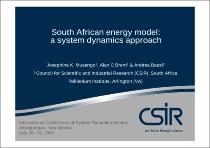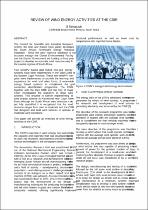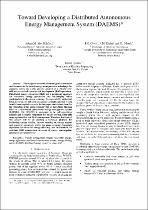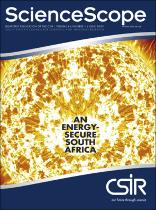JavaScript is disabled for your browser. Some features of this site may not work without it.
- ResearchSpace
- →
- Research Publications/Outputs
- →
- Conference Publications
- →
- View Item
| dc.contributor.author |
Musango, JK

|
|
| dc.contributor.author |
Brent, AC

|
|
| dc.contributor.author |
Bassi, A

|
|
| dc.date.accessioned | 2009-09-08T09:58:55Z | |
| dc.date.available | 2009-09-08T09:58:55Z | |
| dc.date.issued | 2009-07 | |
| dc.identifier.citation | Musango, JK, Brent, AC and Bassi, A. 2009. South African energy model: a system dynamics approach. International Conference of System Dynamics Society. Albuquerque, New Mexico, 26 - 31 July, 2009. pp 1-32 | en |
| dc.identifier.uri | http://researchspace.csir.co.za/dspace/handle/10204/3565 | |
| dc.identifier.uri | http://hdl.handle.net/10204/3566 | |
| dc.description | Poster presentation available from the link below | en |
| dc.description.abstract | This paper provides a South African energy model that was developed as a first step towards a comprehensive Threshold 21 model for South Africa. The energy sector consists of five sub-models, which are structured around the supply and demand of electricity, coal, oil, and natural gas in the sector. The model was used to examine a set of policies that the South African government is currently considering, e.g. expansion of nuclear energy production and implementation of more stringent energy efficiency measures. The analyses show that energy efficiency measures are indeed the best option to curb the supply and demand constraints, which the energy sector faces, in the short term. In general, the paper demonstrates how a system dynamics approach can be utilized effectively to support understanding of energy-related issues and clarify the advantages and disadvantages related to the options available to government and the private sector. The paper also highlights potential pitfalls that may be encountered when building such a model. Future developments include extending the model to incorporate the linkages between the energy sector and the economy, society and environment, which would complete the T21 framework for South Africa, and extending the model, with models for other countries in the region, to the Southern African Development Community. | en |
| dc.language.iso | en | en |
| dc.subject | South African energy model | en |
| dc.subject | System dynamics | en |
| dc.subject | Energy demand | en |
| dc.subject | Energy efficient | en |
| dc.subject | Energy modelling | en |
| dc.subject | Threshold 21 | en |
| dc.subject | T21 | en |
| dc.subject | System dynamics society | en |
| dc.subject | Electricity generation | en |
| dc.subject | Oil | en |
| dc.subject | Gas | en |
| dc.subject | Coal | en |
| dc.subject | Nuclear energy expansion | en |
| dc.subject | Policy analysis | en |
| dc.title | South African energy model: a system dynamics approach | en |
| dc.type | Conference Presentation | en |
| dc.identifier.apacitation | Musango, J., Brent, A., & Bassi, A. (2009). South African energy model: a system dynamics approach. http://hdl.handle.net/10204/3566 | en_ZA |
| dc.identifier.chicagocitation | Musango, JK, AC Brent, and A Bassi. "South African energy model: a system dynamics approach." (2009): http://hdl.handle.net/10204/3566 | en_ZA |
| dc.identifier.vancouvercitation | Musango J, Brent A, Bassi A, South African energy model: a system dynamics approach; 2009. http://hdl.handle.net/10204/3566 . | en_ZA |
| dc.identifier.ris | TY - Conference Presentation AU - Musango, JK AU - Brent, AC AU - Bassi, A AB - This paper provides a South African energy model that was developed as a first step towards a comprehensive Threshold 21 model for South Africa. The energy sector consists of five sub-models, which are structured around the supply and demand of electricity, coal, oil, and natural gas in the sector. The model was used to examine a set of policies that the South African government is currently considering, e.g. expansion of nuclear energy production and implementation of more stringent energy efficiency measures. The analyses show that energy efficiency measures are indeed the best option to curb the supply and demand constraints, which the energy sector faces, in the short term. In general, the paper demonstrates how a system dynamics approach can be utilized effectively to support understanding of energy-related issues and clarify the advantages and disadvantages related to the options available to government and the private sector. The paper also highlights potential pitfalls that may be encountered when building such a model. Future developments include extending the model to incorporate the linkages between the energy sector and the economy, society and environment, which would complete the T21 framework for South Africa, and extending the model, with models for other countries in the region, to the Southern African Development Community. DA - 2009-07 DB - ResearchSpace DP - CSIR KW - South African energy model KW - System dynamics KW - Energy demand KW - Energy efficient KW - Energy modelling KW - Threshold 21 KW - T21 KW - System dynamics society KW - Electricity generation KW - Oil KW - Gas KW - Coal KW - Nuclear energy expansion KW - Policy analysis LK - https://researchspace.csir.co.za PY - 2009 T1 - South African energy model: a system dynamics approach TI - South African energy model: a system dynamics approach UR - http://hdl.handle.net/10204/3566 ER - | en_ZA |










